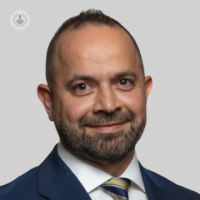An in-depth exploration of fibromyalgia: part 1
Written by:According to a recent study in Scotland, it was found that about 5% of the Scottish people would receive a positive diagnosis for fibromyalgia using the criteria set by the American College of Rheumatology. Extrapolating this data to the UK's population, it is estimated that roughly 3 million people in the country are currently coping with the challenges of fibromyalgia. In the first article of a two-part series, leading consultant in pain medicine Dr Husham Al-Shather explores fibromyalgia, explaining triggers and misconceptions about the condition.

Living with fibromyalgia
Living with Fibromyalgia presents a multitude of challenges, both physical and emotional. The experience can be overwhelming as the sufferer battles not only widespread pain, but also symptoms of fatigue, difficulty concentrating, and memory problems. As much as people say they get used to it, the truth is that living with this condition is a constant battle. Thankfully, with continuous advancements in research and technology, those with fibromyalgia now have a greater array of treatment options available to them. These include both pharmaceutical and non-pharmaceutical approaches, all aimed at improving their overall quality of life, even though the condition cannot be cured.
What is fibromyalgia?
Fibromyalgia is a persistent condition characterised by widespread musculoskeletal pain and tenderness throughout the body. Alongside these symptoms, there are three other key symptoms: sleep disturbances, memory/concentration issues, and fatigue.
Diagnosis typically requires the presence of all four primary symptoms for a minimum of three months, with blood tests showing no signs of infection or other explanatory factors for the pain. The condition involves a heightened sensitivity of the central nervous system, leading to exaggerated responses to touch and even minor impacts, resulting in significant pain across the body.
Futhermore, diagnosing fibromyalgia can be challenging due to the subjective nature of many of its symptoms, making it difficult to pinpoint the underlying cause. While the exact origins of fibromyalgia remain uncertain, it has been associated with various factors such as physical or emotional stress, as well as traumatic events, which may contribute to the development of the condition.
What triggers fibromyalgia?
While the exact cause of fibromyalgia remains elusive, there are several triggers that are believed to contribute to its development. Research suggests that one primary trigger is an imbalance in brain chemicals, indicating a disturbance in the central nervous system. Additionally, there is evidence to suggest a genetic predisposition to fibromyalgia, with individuals potentially inheriting certain genes from their parents.
Other factors that can lead to the development of fibromyalgia include:
- Pre-existing pain-related conditions such as rheumatoid arthritis
- Traumatic events such as car accidents or surgical procedures
- Infections
- Childbirth
- Grief from the loss of a loved one
- The end of a relationship
Common areas of the body where pain may manifest include the hips, knees, upper chest, back of the head and neck, shoulders, elbows, feet, and arms.
What are some misconceptions about fibromyalgia disorder?
Unfortunately, due to the ambiguity surrounding its origins, many doctors do not acknowledge fibromyalgia as a legitimate medical condition. This disbelief, coming from a trusted healthcare professional during the initial interaction, can be demoralising and even exacerbate the perceived pain. I regularly encounter patients in my clinic who have been accused of simply imagining their symptoms. It is important to note that there are no signs of inflammation typically associated with other chronic rheumatological disorders.
Despite this, fibromyalgia is a very real and painful condition, comparable to other joint-related disorders like arthritis. While it is true that the condition is characterised by abnormal pain perception and transmission in the brain, it is not merely a figment of the mind. The sufferers truly experience debilitating symptoms.
Doctors have recognised the legitimacy of this disease and are dedicated to assisting individuals in managing the associated discomfort. However, the lack of a cure for this disorder has presented challenges in the process.
If you suffer from fibromyalgia and would like to book a consultation with Dr Husham Al-Shather, do not hesitate to do so by visiting his Top Doctors profile today


